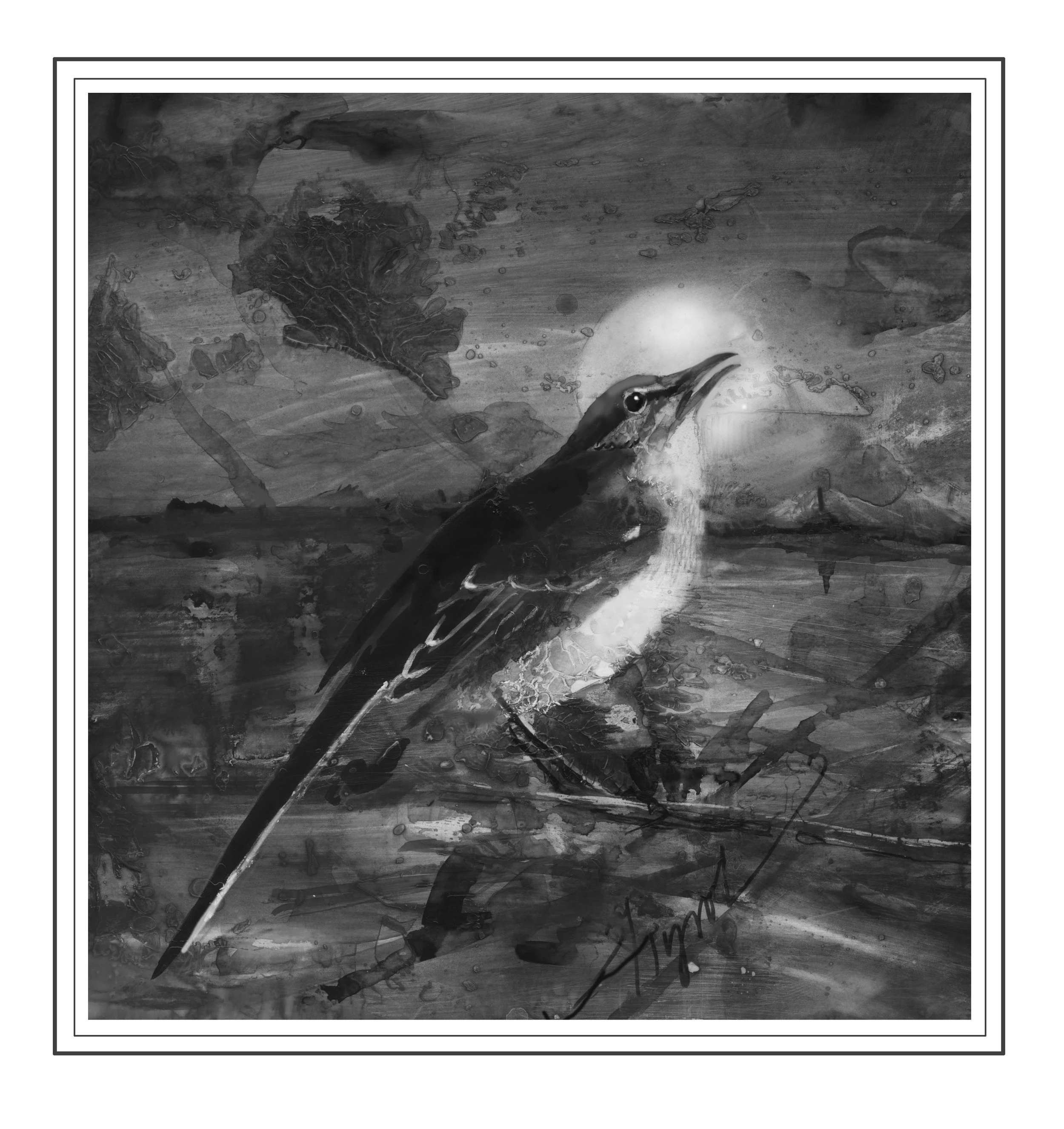The Outside Story | The Northern Mockingbird: Master of Mimicry
July 13, 2023 | By Laurie D. MorrisseyIllustration by Adelaide Murphy Tyrol
When I worked on a college campus, a northern mockingbird often accompanied me on the walk between my car and my office.
This slender gray bird darted from the hedges, flashing white wing patches and outer tail feathers before landing on a crabapple branch, where it poured forth a string of trills and phrases, sounding like several different birds singing and calling one after another. A noted mimic, the northern mockingbird is in the same family as the brown thrasher and the catbird.
Mimus polyglottos (Latin for many-tongued mimic) is North America’s only native mockingbird. A few decades ago, this species was relatively rare in northern New England, but its range has expanded northward as far as southern Canada. It is found mainly at lower elevations, in human-created landscapes. It does well in suburban areas, often staying through the winter and surviving on berries and fruits including sumac and holly. Mockingbirds also eat the fruit of multiflora rose, an aggressive invasive shrub that has populated old fields, pastures, and roadsides – and may be one reason for the mockingbird’s expansion.
This robin-sized bird has several interesting behaviors, including aggressively defending its nest from predators. “They’ll fly at you and actually hit you on the top of your head if you get too close,” said Rebecca Suomala of New Hampshire Audubon. The birds also have a feeding behavior known as “flush pursuit.” Foraging on open ground, a mockingbird runs several steps, stops, and flashes its wings, startling insects, spiders, and other prey out of hiding.
But the northern mockingbird’s reputation rests on its impressive mimicry, which ranges from other birdsong to insects, frogs, and human-made sounds such as car horns, sirens, rusty hinges, and musical instruments. Unmated males even sing at night, especially during the full moon or near streetlights. Avian experts often field calls from disturbed sleepers. “They ask if there’s anything they can do,” said Suomola. “I suggest that they go scare the mockingbird away every time, and maybe they’ll get out of the habit of singing in that spot.”
While young songbirds typically learn songs from adults of their species, most species do not continue adding to their repertoire after a year or so. But male mockingbirds – and other mimics – add phrases every year, and mockingbirds may learn more than 200 songs. Although catbirds and brown thrashers tend to have a greater number of songs, the mockingbird’s playlist includes more songs that are distinctly imitative.
Donald Kroodsma, author of “The Singing Life of Birds” and “Birdsong for the Curious Naturalist,” is one of the world’s leading experts on the topic. “I think of the mockingbird with about 100 songs, the catbird with 200 to 400, thrasher with 1,000 to 2,000,” he said. “All three mimic, but the mockingbird mimics far more than the other species. The catbirds and thrashers have far larger repertoires because they improvise their songs, making them up.”
Another difference between these avian mimics is the number of times their songs are repeated. Brown thrashers sing phrases twice before moving on, while mockingbirds usually sing a phrase three to seven times. Catbirds do not typically repeat phrases back-to-back, but produce an irregular succession of notes and phrases.
In “The Singing Life of Birds,” Kroodsma describes an unmated male mockingbird singing 465 songs in 26 minutes. This performance included songs of seven species, repeated 2 to 8 times apiece, separated by pauses of about a second and a half. He estimated that with a reach of at least a quarter of a mile, the bird’s recital reached dozens of mockingbird territories.
The male mockingbird’s mimicry advertises his breeding territory to other males, warns competitors away from the food supply, and attracts females. Biologists believe that the quality and quantity of the repertoire are factors in mate selection. The older the bird, the more songs he’s picked up, and females may find mature males to be the most alluring.
Mockingbirds sing almost constantly during mating season, slowing down once they have secured a female partner. Singing picks up again after the eggs hatch, just before a potential second nesting cycle.
With all that is known about mockingbirds, I am still curious about what makes them able to imitate so many sounds. Is it something about this bird’s brain or the anatomy of its syrinx? And why do they imitate other species – or a chainsaw or a washing machine? Even Kroodsma says he doesn’t know. “I don’t think that anyone has an answer to that,” he said. As any scientist knows, there is always more to learn.
Laurie D. Morrissey is a writer who lives in Hopkinton, New Hampshire. The Outside Story is assigned and edited by Northern Woodlands magazine and sponsored by the Wellborn Ecology Fund of the New Hampshire Charitable Foundation.

